With Sky & Telescope's editors and writers scattered across the eclipse path, we have dozens of stories to share. Here are a few.
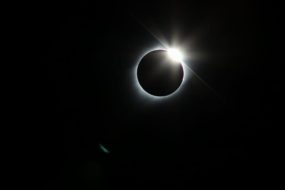
Gert Cazemier
To experience a total solar eclipse is to experience the sublime. It is to encounter something so awe-inspiring, so earth-shattering, that you lose all capacity for reason. Even if you understand the celestial alignment above, you often react in ways that you never expected.
At least that's what accounts of the celestial spectacle often say. At Sky & Telescope, we have been poring over these accounts for years — wondering what our personal reactions might be to the Great American Eclipse. Now that August 21, 2017, has come and gone, we no longer have to wonder. In fact, we can now add our own stories to the pool of others.
Of course, it might still be impossible to speak lucidly about the event. Jay Pasachoff — an astronomer at Williams College who has seen 34 total solar eclipses — notes that no one has ever described a total solar eclipse adequately. But we wouldn’t be writers if we didn’t try.
In the Coast Range, Oregon
My wife, Kathy, and I had planned to watch the eclipse from Newport, Oregon, which would make us among the first people to see it. Alas, that morning we awoke to heavy fog and the forecast was not good. So we piled all our gear into the car and drove eastward. We expected the roads to be jammed, but traffic was surprisingly light. Unfortunately, the site for our plan B, which was seven miles inland was also socked in, as was the site for our Plan C. At last, 25 miles inland we broke free of the fog and a couple miles farther along we found a southeast-facing clearcut we could set up in.
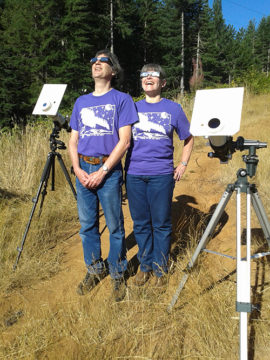
The sky was as clear and deep blue as I've ever seen it, washed clean by the fog and free of the smoke that plagued sites farther east. We watched the eclipse unfold with solar shades, filtered binoculars, a filtered Short Tube 80 and an H-alpha scope, sharing the view with another couple who were observing from the same clearcut. We were hopping up and down with delight as the eclipse unfolded, mostly because of the amazing spectacle itself but also with giddy relief over our last-minute escape from the fog.
Totality was indescribably beautiful by naked eye, but the image that will stick with me forever is the view through the Short Tube 80 without a filter at about 28x. There were three prominences that stood out in sharp contrast above the solar disk, and they were in beautiful full color. I have observed prominences in H-alpha many times, but the full spectrum view was far and away more impressive.
Totality was over far too soon. We forgot to look for shadow bands or Mars or Mercury or the ring of sunsets around us; we only had eyes for that spectacular corona. The second diamond ring was both beautiful and tragic as it marked the end of totality.
When we got back to Newport we learned that the fog had lifted and everyone in town had been able to watch the eclipse, too. The entire town was abuzz with excitement. For the rest of the day we all shared a single thought: When and where can we do this again?
— Jerry Oltion, Sky & Telescope Contributing Editor
In Sun Valley, Idaho
It already feels like a dream. Early this morning, my husband and I climbed a small hill in Sun Valley, Idaho, with a couple hundred friends: astronomers all in town for the American Astronomical Society’s High Energy Astrophysics Division (HEAD) conference. Together, we set up small solar telescopes, eagerly talked about the forthcoming shadow and watched as the moon’s bite grew bigger and bigger.
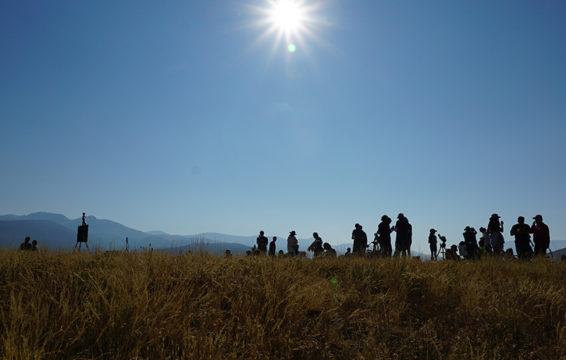
Shannon Hall
But with mere minutes leading up to totality, the scene started to shift. Talking dwindled as the winds picked up, the shadows sharpened and the horizon transformed into a surreal image — like one of those romantic landscapes painted toward the end of the 18th century. Then, the crowd started to gasp. Only, they weren’t staring at the Sun, but the mountains to the west of us that had turned black — the eclipse’s shadow was racing toward us at 2,700 kilometers per hour.
We knew we had only seconds before the darkness reached us. Rapidly we swung around to see the Sun as it slid away, replaced by a black hole in the middle of the inky sky. It was fringed with a ring of soft white fire. A chorus of screams, cheers and applause erupted from those surrounding me. Rumor has it that a line of planets and winter constellations surrounded the ring, but I could barely see them. My eyes were glued to the ethereal corona, which started to sway violently as tears slid down my cheeks.
But it ended as quickly as it began. In no time at all, the moon started to slip further past the Sun and the system brightened like a diamond ring. The world grew warm and bright, as though it was stirring awake after a surreal dream. “That’s one of the saddest things I’ve ever felt — totality ending,” my husband later told me.
Writing these words now, I still feel as though I’m wandering between a dream and reality, uncertain of what is true — save for one thing: I will be in Chile for the next total solar eclipse.
— Shannon Hall, Freelance Journalist and Contributing Writer to Sky & Telescope
In Rexburg, Idaho
The weirdest thing about Monday’s total solar eclipse: The eerie quietness in the town of Rexburg, Idaho. Long in advance, Rexburg had been championed as one of the best possible places to watch the celestial spectacle. So, when I started to organize a Dutch eclipse tour with SNP Travels in Nijmegen, the Netherlands, I knew I wanted to take our group of 33 there. And given all the horror stories about millions of American eclipse watchers on the move, we expected congested highways and a crowded town.
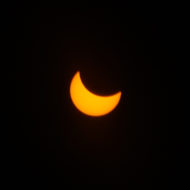
Mike DiPompeo
To our surprise, there was little traffic the day before the eclipse, and Rexburg seemed deserted. Yes, our hotel (like all others in town) was fully occupied, but temporary parking lots and camping spaces remained largely empty, even on eclipse day. Apparently, many Americans had decided to stay home after all — maybe frightened by the same horror stories, and by ‘fake news’ about potential power failures and other imagined disasters that might be caused by the eclipse.
Too bad for them. At the Rexburg campus of Brigham Young University, we experienced a picture-perfect show that went by the book from beginning to end. Crystal-clear skies, building excitement, brilliant Venus, approaching darkness, a beautiful corona with splendid streamers, dusk colors on the horizon, a dazzling diamond ring at third contact — it couldn’t have been any better. Of the thirteen totals I’ve witnessed so far, this one is absolutely in the top-three of most beautiful eclipses.
Some of the members of my group had never seen a total solar eclipse before. Others saw their third, fourth or even eighth. But everyone knew this wouldn’t be the last — the eclipse chaser virus is spreading fast and we’re already planning our next adventure in Chile, in July 2019.
— Govert Schilling, Sky & Telescope Contributing Editor
In Jackson, Wyoming
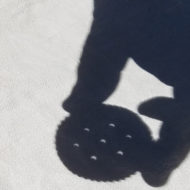
Jim Bell
What a show! I had the pleasure of traveling to Jackson Hole, Wyoming, with a Betchart Tours group of about 100 members of The Planetary Society, the American Association for the Advancement of Science and the Sigma Xi Honor Society, to witness today's glorious 140 seconds of totality. We took the tram from Jackson Village up to Rendezvous Peak (elevation 10,928 feet), where we joined somewhere between 800 and 1,000 other shadow seekers for a wonderful eclipse party.
From that height, in the thin cloudless air and above the tree line, we were all treated to nearly 360 degrees of gorgeous, colorful twilight along the horizon during the all-too-brief time of totality. A number of folks spotted Bailey's Beads via naked eye and spotting scope observations, and we were treated to some wonderful displays of shadow bands just before and just after totality. The atmosphere was festive and it was especially delightful to see so many children and young people enjoying one of nature's most amazing spectacles. By the end, many of us were already scheming about how to get ourselves to South America for the next total eclipse in July 2019!
— Jim Bell, President of The Planetary Society and a Contributing Editor to Sky & Telescope
In Jackson, Wyoming
I waited for the shadow of the moon with a group of 30 or so relatives, friends, and friends of friends on a hill outside Jackson, WY. The sky was a brilliant blue, hardly a cloud to be seen. As the eclipse advanced through the crescent phases, we all looked for crescents in the shadows under trees and made our own crescent-shaped shadows using everything from colanders and tin foil to our hands. My son and I kept an eye on the sky using our solar glasses and pinhole projectors, and I watched through my sunoculars — at times I was certain I could actually see the moon moving across the Sun's face.
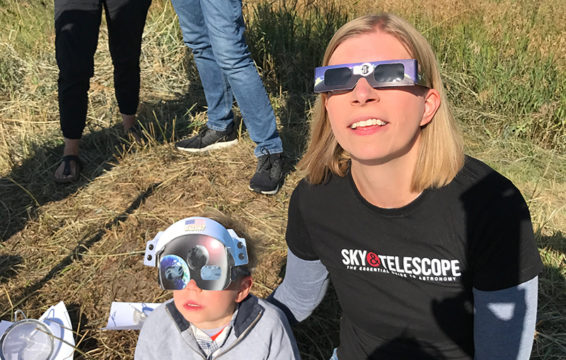
Soon enough, only a thin crescent remained. The air had become dawn-cold and the sunlight looked oddly silvery. The dogs began to wander nervously around the site, switching this way and that — they knew something was happening. I can only imagine how a feeling of doom or nerves might have overcome an ancient ancestor who didn't understand what was happening, but all I could feel was my heart drumming with excitement.
Suddenly, darkness fell on the western horizon and two white birds flew up to roost in a nearby tree. Tearing my eyes from the sunset-colored horizon, I looked back at the Sun just in time to see the brilliant flash of the diamond ring. "Glasses off!" we all shouted. There it was — a black hole in the middle of the sky. The ethereal glow of the corona surrounded the eclipsed Sun, and I realized for the first time how far the Sun's reach really is. How incredible that this corona is always there and we only then, in those two minutes, had the chance to witness it ourselves! Venus was shining brilliantly just to the west. I grabbed my binoculars for a glimpse of the corona's white tendrils, the pink prominences at the edge of the eclipsed Sun, and Regulus nearby, before passing the binos on to the next person wanting a glance. Then, somehow, it was already over — we watched the moon glide over the Sun, revealing the second brilliant diamond ring, and sunlight returned, seemingly more quickly than it had disappeared.
Now the only question I have is, how can I get to Chile in 2019 to see the next total eclipse of the Sun?
— Monica Young, Sky & Telescope's News Editor
In Casper, Wyoming
Casper, Wyoming really went above and beyond to host visitors on the line of totality. My wife and I arrived on Thursday and the town’s eclipse festival was already in full swing. The small downtown area was awash with eclipse chasers from all over the world and the excitement was simply electric. Each night saw the crowds increase and the party atmosphere intensify. Main streets were blocked from vehicle traffic, mobbed with foot traffic, and filled with entertainers, memorabilia merchants and food. I suspect that this was repeated all along the path of totality, but I was quite happy to have chosen Casper to enjoy this eclipse. The AstroCon (Astronomical League Convention) going on in Casper was just icing on the cake. More than a dozen of my friends from the Huachuca Astronomy Club of Southeastern Arizona were in town and several other members were spread out along the path, keeping in close touch.
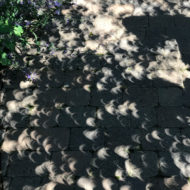
Monica Young
Eclipse day dawned clear and the early morning forecast looked perfect, but things changed as totality approached and a high thin cloud began to cover much of the sky. As the clouds thickened, there was an unspoken undercurrent of dread infecting the crowd visibly struggling to remain positive and optimistic. In the end, it wasn’t much of an issue at all. Totality was everything we hoped for. The fastest two and a half minutes anyone there had ever experienced and undoubtedly the most remarkable phenomena nature has to offer.
I chose the parking lot of our hotel (along with about 200 hundred of my closest friends) to view the eclipse. This is an astronomical event that just has to be shared to fully appreciate and it was a big enhancement to be surrounded by friends. Their excitement just multiplies the sheer joy. An active Sun was an unexpected bonus; I kept thinking how very fortunate we were to have so much interesting activity on our star to augment the event.
Our trip to Casper was two years in planning and represented a considerable investment in both time and treasure, but I can say in hindsight that I can’t think of a better place to have witnessed the Great American Eclipse and couldn’t be more pleased with the results. Can’t wait for the next opportunity to feel the shadow!
— Ted Forte, Sky & Telescope Contributing Editor
In Glendo, Wyoming
Dotting the school field of the little town of Glendo (non-eclipse population: 205), approximately 200 of us set up with equipment, chairs, and elation over the pristinely clear skies. Most of us had never before seen totality. Knowing that, we’d prepped the group with an extensive briefing the night before and an eclipse trivia game that morning — the latter to keep us entertained while sitting on our five buses, awaiting our turn at the traffic-jammed exit ramp into the hamlet.
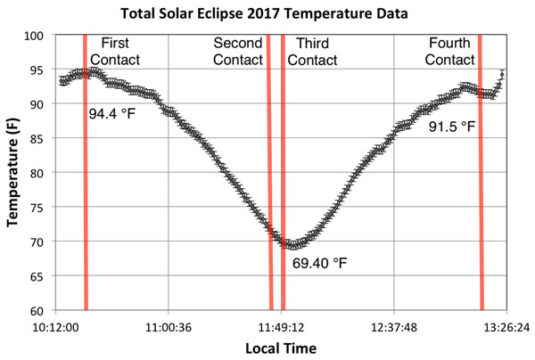
Vishnu Reddy
The town’s facilities were shut down, leaving us dependent upon clusters of port-a-potties. Cell service was patchy at best. Still, we were a merry picnic of a group. Outreach astronomer Jason Kendall and I stationed ourselves at opposite ends of the field, shouting out timing alerts as the Moon approached, then began taking bigger and bigger bites out of, the Sun. The sunlight’s intensity on my skin weakened as the infrared and ultraviolet waves reaching my pasty complexion grew fewer. Over the western horizon, the sky darkened. The shadow was coming.
The wind died down. The light transformed into silvery twilight. And then, the glare disappeared, and an elegant haloed black disk hung in the sky. Pink prominences festooned the edges, the only bit of color to the bizarrely black-and-white celestial hole punch. A sunset-like glow wreathed the horizon.
Perhaps I was overly sensitive to the passage of time, stationed as I was with headphones in, listening to countdowns from my smartphone app, but to me totality was respectably long — long enough for me to share binoculars and point things out to others, anyway. And then, after 2½ minutes, a fantastic diamond ring appeared. I vainly struggled to make out Baily’s beads.
As the Moon slowly gave back the Sun, I walked around asking for people’s reactions. One of our tour guides said, “I can’t even talk about it.” Another man said that he’d been worried beforehand that the spectacle was hyped, that he’d be too cynical to enjoy it — but totality bowled him over, leaving him flabbergasted.
— Camille M. Carlisle, S&T Science Editor
In Lusk, Wyoming
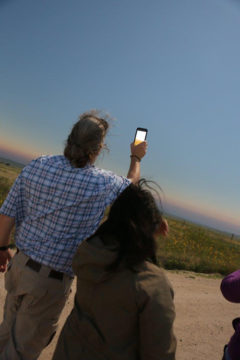
Trudy E. Bell
I had originally hoped to photograph the eclipse over the copper dome of the 19th-century Boswell Observatory at Doane University in Crete, Nebraska, but all weather reports predicted clouds and thunderstorms. The best weather odds seemed to be in eastern Wyoming, more than 500 miles west. So at 3 a.m. on Monday, Doane University professor Brad Elder and his wife Amanda Kuhl — who two nights earlier had fired up the foundry in their driveway and let my daughter Roxana and me pour 2-inch mirrors out of molten speculum metal — picked us up and headed west at 80 mph, apprehensive about thick ground fog reducing visibility in the Platte River valley. We arrived at Road 12 and U.S. Hwy 85 south of Lusk, WY, about half an hour before first contact, relieved that the fog had melted into general haze. Already several thousand campers, SUVs and cars were lining US 85 with cameras aimed sunward. Among the hundreds of vehicles, we easily found a spot on a rise only a few hundred yards from the center line of the path of totality, with a clear view to the northwest and southeast to see the lunar shadow.
Brad, Amanda and Roxana had never seen a total solar eclipse (I was five for five). Although we occasionally glanced upward through eclipse glasses, mostly we watched the partial phases using an ingenious solar viewer built and shipped to me by a longtime friend and sometime coauthor Karl Esch, who was himself eclipsing in Oregon. We all hoped to see the flickering that heralded shadow bands, but saw nothing (I suspect the haze washed them out), but we were delighted with the abundance of crescents falling on our shoulders through straw hats. Then totality dropped, and we gazed euphorically up into the midnight blue heavens at the feathery white corona surrounding the black disk of the moon. It was over far too quickly.
People in other cars were grinning and in a festive mood even with the exiting traffic. We encountered no price gouging reported from other areas. Thunderstorms moved closer and rain was falling when we got back to Crete at 11 p.m., 20 hours and 1,050 miles after our adventure began, And for better or worse, weather had held good in Crete for the city to enjoy the eclipse as well.
— Trudy E. Bell, Sky & Telescope Contributing Editor
In Alliance, Nebraska
My family and I had great weather for the eclipse. We drove northwest from Lewellen to a point about 8 miles south of Alliance, Nebraska. Heavy fog burned off by 9 a.m. leaving perfect skies. A farmer along the highway was offering eclipse parking for a modest fee, which we gladly paid to get off the road and into a picturesque area.
The change in daylight was obvious as early as 80% partial eclipse. By 90% it was dramatic, but along with the falling temperatures, masses of clouds were quickly forming at the top of the sky. We used the clouds as a filter during the delicate crescent phases, and then just as quickly as the clouds blew in, a big clearing appeared, which the sun rolled into just moments after the start of totality. Wonderful!
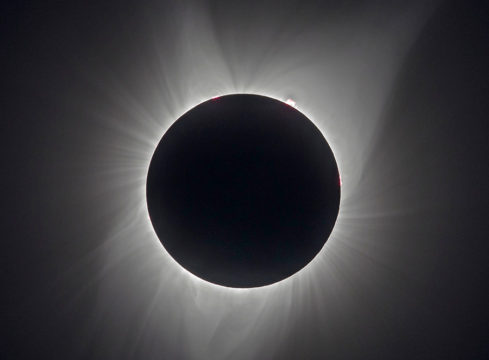
Johnny Horne
It was a wildly beautiful eclipse with a stunning corona remarkably like the prediction. Long and stretchy with beautiful magnetic filaments crowning the north and south polar regions set in a deep blue, cloudless sky. Regulus was easy to see in 10x50 binoculars just outside or maybe even a little inside the corona; Venus brilliant to the west with the naked eye. Many of us were screaming and shouting. For me, it was two and a half minutes of crazy joy.
The approaching moon's shadow was very clearly seen — grey and ashen. There was also a sense of the moon being "on fire" with Baily's Beads just before and after totality. The sudden return of the sun was shockingly fast.
It was a scene of tremendous beauty.
— Bob King, Sky & Telescope Contributing Editor
In Franklin, Kentucky
Speechless. We gathered in a field behind the Quality Inn — about 50 of us, most of us had never met before. I called out first contact when the moon made its presence known in front of the Sun. The crowd cheered. Then came the agonizing 90 minute wait for totality. Would those clouds on the horizon ruin the whole thing? I never relaxed until about five minutes before totality when I finally accepted we would all see it. The crowd asked that I tell them when totality began, so I rehearsed what I would say to signal this heavenly sight. But at the appearance of the diamond ring, I simply yelled, "It's started! Look at it!" And those were the last words I could coherently utter for the next 2 minutes and 30 seconds.
— Dean Regas, Sky & Telescope Contributing Editor
In Hopkinsville, Kentucky
"Agog" is a word that isn't used much these days, but it captures the overall vibe we had at Hopkinsville Community College, the site for Sky & Telescope's "eastern" eclipse tour. Our group of 210 came from all over the globe — from Hong Kong and New Zealand to Qatar and Norway — to be part of the group. More than 90% of them had never experienced totality before, so all these first-timers had off-the-chart levels of excitement and anticipation.
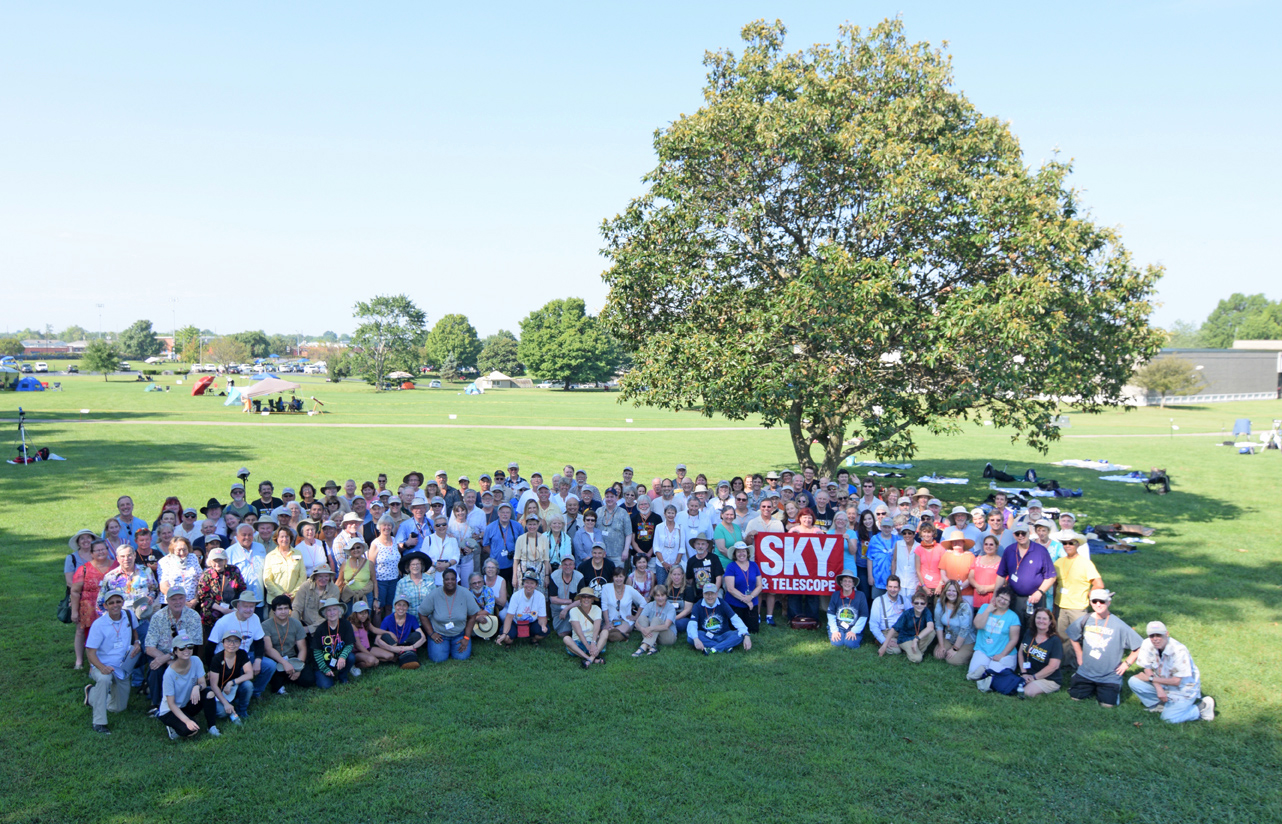
Sky & Telescope / Kelly Beatty
The four-person ground team from Insight Cruises and I had worried all night about the weather, as clouds were headed our way from the Midwest. But eclipse day dawned clear, and we headed out from Nashville before dawn in five giant buses. The campus staff really made us feel welcome, offering an exclusive viewing area and allowing us access to its indoor facilities to escape the heat and humidity of a midsummer day. Tables and chairs under a huge canopy offered relief from the heat.
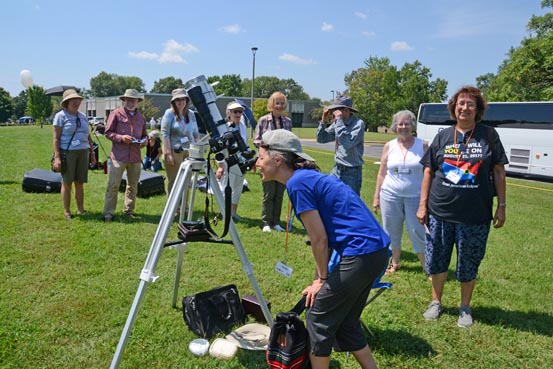
Sky & Telescope / Kelly Beatty
Some people came prepared with lots of gear, but most had nothing more than binoculars (if that) to enjoy the show. Clearly, they'd heeded S&T's advice to just enjoy this spectacle by eye instead of wasting the precious 2m 40s of totality by fiddling with cameras. I had one of the few telescopes set up for strictly visual viewing (thus heeding my own advice), and once the eclipse was under way I hosted a constant stream of visitors wanting a peek of the Moon's advancing silhouette.
This was my 12th trek into the path of a total solar eclipse, so I had a pretty good idea of what to look for and when. Looking northwest, I saw only a hint of the umbra approaching us at supersonic speed. Instead, totality's impending arrival was heralded by a gradual dimming of daylight that seemed unusually foreboding to me. I could easily imagine how ancient peoples, caught unaware of the Moon's approaching shadow, would dread that something terrible was about to happen.
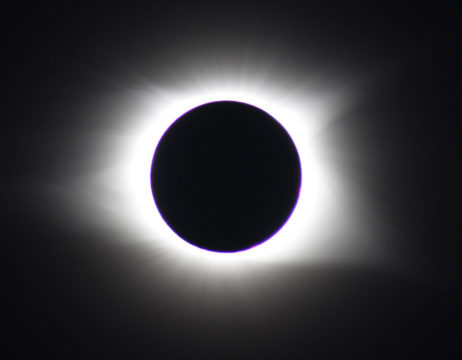
Sky & Telescope / Kelly Beatty
And once we were plunged into umbral darkness, I whooped and hollered along with everyone else. I hugged my wife, Cheryl, as is our tradition, and took a quick look up to track down Venus and Jupiter. After that, my eye was glued to the eyepiece for a wonderful view at 19×. What an amazing corona! Pictures never do justice to the its dazzling, "electric" whiteness. Streamers extended from both sides, as had been predicted, a classic "solar minimum" appearance. I stopped only briefly to snap a few pictures through the borrowed 400-mm lens strapped alongside my scope, with no particular strategy in mind, and these came out surprisingly OK.
I kept track of the time using Wolfgang Strickling's Eclipse Droid app, but of course totality ended far sooner that any of us wanted it to. A great cheer rose as the final set of Baily's beads and diamond ring made their appearance. Although most of the group headed back for the buses relatively soon, many of us hung in for the event's entirety. As fourth contact neared, I took one last look in the eyepiece and thought, "So long for now. We'll meet again in 2019."
— Kelly Beatty, Sky & Telescope Senior Editor
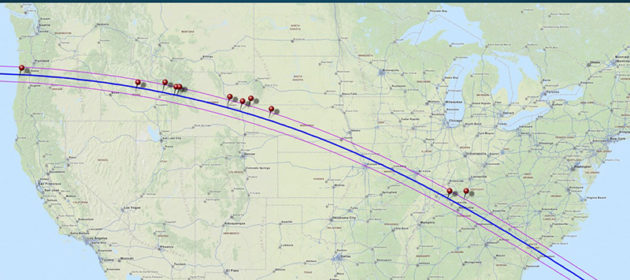
Shannon Hall / Wikipedia
Help us fill in the map above. If you have an eclipse story, please share it in the comments.
 15
15
Comments
George Gliba
August 22, 2017 at 8:14 pm
Early Total Solar Eclipse Report from Cleveland, Tennessee
Lynne and I just got back from seeing Totality from Cleveland, Tennessee. Wow. A photograph will
never capture such awesome splendid beauty ! Cleveland was near the southern edge of totality,
which afforded only about a minute of totality, BUT this allowed a great view of the ruby red colored
Chromosphere to be seen very well; in great detail, showing the ten or more prominences that were visible. The brighter part of the Chromosphere that was visible was seen in the lower "50% of the southern limb of the Sun just after totality started, which moved to the right as totality progressed, ending in the lower right limb by the end to totality. It was ruby red to both the naked eye and with 10x50 binoculars, but only the binoculars showed the many prominences, one of which dominated the end of totality and looked very much like a clawed hand. The Corona was also very awesome and shadow bands were seen for about 8 seconds just before totality. This was my 4th Total Solar Eclipse. They were all cool and all unique, 1991, 1994, 1997,
and now 2017. Come on 2024!
Starry Skies,
G.W. Gliba
You must be logged in to post a comment.
pastorbobnlnh
August 22, 2017 at 9:24 pm
Did I photograph a comet during totality? It is at about 9 o'clock two Son diameters away in this photo on my church website? Or was this an artifact on my camera lens?
http://www.kcpcnlnh.com/presbytube-videos-etc.html
You must be logged in to post a comment.
J. Kelly Beatty
August 23, 2017 at 9:22 am
hey, Pastor Bob... that fuzzy little spec off to the left is the star Regulus, which was indeed about two solar diameters to the Sun's east.
You must be logged in to post a comment.
pastorbobnlnh
August 23, 2017 at 4:13 pm
Thanks for the clarification. I was pretty certain I hadn't detected a comet, even if it looked like one from my very basic camera work.
You must be logged in to post a comment.
Tom-Fleming
August 23, 2017 at 4:11 pm
From near Cerulean, KY
Impressions of the eclipse: I can barely remember any one specific part or the sun's appearance at a given point. I do remember around mid totality looking intently at the sun/corona to burn in the memory. What I found was that I was looking everywhere instead of just the sun and couldn't help myself. The horizons, the ground in front of me, the appearance of the sky, it was all so remarkably different from any form of lighting I had ever seen. I remember looking back to the NW for the end of the shadow. I couldn't see it but I could see a towering cumulonimbus in full sunlight. What I will remember is the profound impact of the ambiance. I'll have the images I took to remind me of what I saw but I don't think I will need help remembering the emotional aura of something this rare.
You must be logged in to post a comment.
Michael-Weasner
August 23, 2017 at 5:20 pm
An Infinity of THANKS to Kelly Beatty, the Sky & Telescope staff who selected Hopkinsville, InsightCruises, and Hopkinsville Community College for an awesome experience. The pre-eclipse events were wonderful and of course Eclipse Day was out of this world!!!! We are so happy that we chose this tour.
You must be logged in to post a comment.
Scott-Bottorf
August 25, 2017 at 12:22 pm
Awesome! Totally awesome. We arrived at our site on the centerline West of Fairmont, NE about half an hour before first contact. The sky was mostly cloudy, but cleared shortly after the eclipse started, and remained clear throughout the event. Our group of 8 spanned six decades in age, and all but one of us were experiencing our first totality. We watched raptly as the moon slowly obscured the solar disk and the light faded around us. Behind us, we turned and watched darkness swiftly approach across a seemingly endless corn field. Totality arrived with stunning swiftness to gasps of amazement from everybody around us. While atmospheric haze prevented us from seeing any stars or planets, the sight of the corona will remain with each of us forever. Numerous prominences were apparent during the 2 minutes and 30-odd seconds of totality. Third contact announced itself with a brilliant diamond ring bursting into view. It was an experience that each of us will always remember. We are already planning for April of 2024.
You must be logged in to post a comment.
Glenn
August 25, 2017 at 4:00 pm
About 13 miles east of Shoshoni WY, an international crowd from Australia, Denmark, Czech republic, 74 yo Larry from Hawaii who'd never seen a total, 23 yo Ehren who drove for 20 hours from St Paul, a guy from Florida and relative locals from across the Colorado border only a 4 hour drive away. A few wispy cirrus clouds added to the 360 degree sunset colours. Pearly coronal streamers of 5 solar radii and 140 seconds of bliss. Diamond rings at 1st and 3rd and only a small temp drop from 73 down to 67. Celebrated with a stubby of Moose Drool beer. LOL............ Glenn
You must be logged in to post a comment.
Repak
August 25, 2017 at 4:35 pm
After enduring endless heat while visiting family in San Antonio, this northern dweller headed to Union, Mo to enjoy totality with my wife and at the centerline home of an Air Force training buddy who we hadn't seen in 40 years. The previous day we pre-flighted all of our equipment, but the official forecast was quite iffy for eclipse day. The day dawned mostly clear, with only thin wispy cirrus to threaten us. My buddy and I worked in the heat and humidity to set things up again, moving a large backyard umbrella into position for relief from the sweaty conditions. At eclipse time, thunderheads began to grow far to the south while it remained virtually totally clear overhead for us. This was my second clear sky viewing of a total eclipse (the first way back in 1970, I was clouded out in Cap Chat, Quebec in 1972). I had a white sheet set up for shadow bands that we never saw. My buddy's old 6" Criterion tracked while projecting the solar image for all of us to monitor. I had a 4" refractor set up with filter to visually track. I wish I had attached my camera, but I heeded the advice instead to simply enjoy the spectacle without fussing with extraneous equipment. When the Eclipse Timer announced "glasses off", Through binoculars we all enjoyed what from all appearances was most simply described as the "black hole in the sky". I breifly looked through the refractor, but immediately went back to taking in the whole sky spectacle. I was most taken by the colors, the faint blueness of the sky, the orange horizon, the prominences along the solar circumference, and the blazing white corona surrounding the starkly black hole with Regulus nearby and a littel farther away, Venus shining brightly as it usually does. Funny how we were all so excited after 1st contact, but after totality ended, we did not bother to view the ending phase, taking equipment down and packing up instead while smiling about what we had just witnessed.
You must be logged in to post a comment.
Paula
August 25, 2017 at 5:18 pm
I drove down to Portland, Oregon from Vancouver, Canada to see the eclipse. I got 'clouded out' the last time I traveled to see an eclipse 18 years ago (I went all the way to Cornwall, England in '99) so I was really anxious about getting good weather in Oregon.
Thankfully Mother Nature was incredibly kind this time around: she blessed everyone in Oregon with fabulous weather! I drove down to The Oregon Garden in Silverton on eclipse day. It was a beautiful venue for an eclipse party. Traffic wasn't too bad to and from Silverton (it was much worse in and out of Salem).
The eclipse was astonishing! Words can't describe it - and pictures (and even a telescope or binoculars) don't do it justice. This is a naked eye experience in its entirety. I felt like I was floating through outer space and looking at a celestial object out there somewhere - not staring at our sun from Earth!
You can see how people can become addicted to viewing total eclipses. It's a once in a lifetime view!
You must be logged in to post a comment.
Tom
August 25, 2017 at 6:11 pm
Manning, South Carolina is a friendly town. Classes were cancelled for the day so everyone could enjoy the eclipse and City Hall opened up the local high school for hundreds of visitors and allowed them to set up shop and watch the eclipse (that didn't stop many others from camping out on the lawn in front of the local Wal-Mart to watch the eclipse there). The high school band boosters set up tents on the football field so people had a shady spot and also saw an opportunity to make some money by selling water and food, which was appreciated by all.
it was a very humid morning and lots of clouds passed overhead, but by noon they had thinned out considerably and from first contact through totality the sky was essentially clear. The crowds let out an audible 'Oooh' when totality occurred, accompanied by applause and cheering - although the real geeks and nerds (like me) were busy at their cameras taking as many pictures as they could! The sun at totality was absolutely gorgeous, set in the deep blue sky and surrounded by a multi-streamered corona. Totality lasted for 2 minutes and 17 seconds in Manning according to the clocks, but subjectively it was over in a flash.
I plan on being retired and free to do a much better job of photographing the 2024 eclipse and surroundings!
You must be logged in to post a comment.
Paul
August 26, 2017 at 2:58 pm
We watched the eclipse from Sweetwater, Tennessee. (Nice job, Sweetwater!) An hour before first contact, the sky was about 40% covered with cumulus clouds. As the partial eclipse began, the clouds began to evaporate and where all gone at least a half hour before totality. 40 to 50 minutes before totality, a noticeable breeze began to pick up from the west and the temperature began to drop. I would estimate the total temperature drop to have been around 15 degrees, from near 90 to the mid 70s. As second contact approached, the entire area took on an eerie twilight coloration and the noise of the crowd (we shared the eclipse with around 5,000 other people) became muted. Being my first total eclipse, I missed the Bailey’s beads and diamond ring at the beginning, but the 2′ 37″ of totality were spectacular. Cheering all around. I could only see Venus and Jupiter. I suspect that there was just enough haze to wash out the other planets and stars. Third contact brought a beautiful diamond ring and, I think, Bailey’s beads, although I’m not sure that is what I saw.
The only downer: the trip back to our hotel in Knoxville that took 40 minutes at 5:30 AM took 3:20 minutes at 3:00 PM.
As I live in Cleveland, Ohio, I look forward to seeing many of you in April, 2024, for the next Great North American eclipse.
You must be logged in to post a comment.
Rob
August 26, 2017 at 10:50 pm
We had planned to go to St Joseph, MO but indications were that St Joseph would be cloudy at the time of totality. I decided to drive east along the I70 to Boonville 86 miles away. The sky cleared gradually on the journey to rising spirits. As the eclipse progressed the sky was gradually getting more hazy and with a half hour to go cumulus clouds were appearing. The situation worsened as totality approached, at 10 minutes to go it looked bad with a thunderhead over the sun, at 5 minutes there was rain! Amazingly with 2 minutes to go the clouds cleared and the Sun appeared in a clearer sky than before as we watched the slowly decreasing crescent. At totality the view through my 4" reflector was stunning, with a large prominence visible and great detail in the corona. Well worth the drive and a most memorable day.
Rob, Angela & Helen
You must be logged in to post a comment.
GIULIO-PECORA
August 26, 2017 at 11:24 pm
My wife and I travelled all the way from Rome, Italy, to Baker City, Oregon, to see and film the eclipse.
We selected Baker City after having carefully read Fred Espenaks's book on the weather statistics along the path of totality. The skies were absolutely blue, the air crispy and the temperature balmy (Baker City is 3,100 feet high). We have never been strong believers in the "magic" of a total eclipse of the sun, but this experience has converted us. Despite being very fond of astrophotography, we followed Fred Espenak's advice and decided to observe the eclipse with our own eyes rather than fumbling with cameras and scopes while trying to photograph it. Wise decision, because we are now able to recall every single moment of those 95 seconds of totality. But we didn't give up photography entirely: We let a camera with a 500mm catadioptric lens mounted on a small astrotracker film the event while we enjoyed it visually. Here is the link to the video:
https://www.youtube.com/watch?v=OVnCl5GRtY0
That's all regarding the eclipse. But it is realy worth mentioning how great was for us to discover North Eastern Oregon. The friendliness of the people of Baker County, the sheer beauty of those mountains, the majestic flowing of the Snake river, are all fantistic aspects of a region that has a lot of character and presents the visitor with unique aspects of the country. Wow! What a trip!
Giulio and Claude Pecora
You must be logged in to post a comment.
Chris-Dalla Piazza
August 29, 2017 at 2:09 pm
We got to experience totality from Lime, Oregon which is an abandoned town off of what I would call the centerline exit of I-84. It was entertaining to watch what I would call a squatters town of RVs, tents, and car campers form over the 24 hours leading up to the eclipse. The local sheriff's office was very professional and patient as they kept everyone out of an abandoned cement factory at the location for the sake of safety.
The one thing that I hadn't seen mentioned before was that we were able to spot Capella ~ 15 minutes prior to totality. In fact I mistook it for Venus at first it was so obvious. I think the reason others may not have seen it farther east aside from sky conditions was because at our location the sun was a little lower and Capella was well placed very close to the zenith.
3rd contact was punctuated by a fly over from a 4 engine jet aircraft that came so close to the eclipsed sun that its contrail was lit up by the appearance of the diamond ring exactly as it passed the sun. The thundering sound of its engines made it a sort of fireworks finale to complement the end of totality!
You must be logged in to post a comment.
You must be logged in to post a comment.